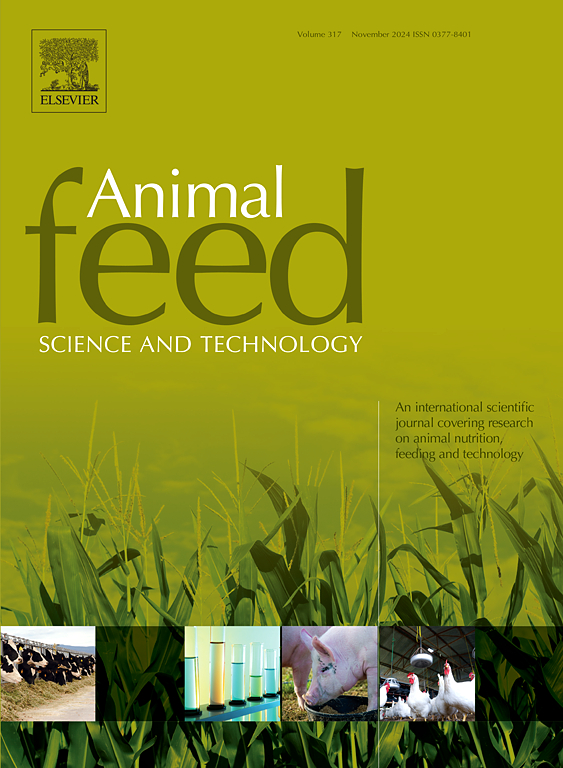单月桂酸甘油可减少草鱼高脂饲料中脂肪沉积,促进肝脏和肠道健康
IF 2.5
2区 农林科学
Q1 AGRICULTURE, DAIRY & ANIMAL SCIENCE
引用次数: 0
摘要
本研究旨在探讨单月桂酸甘油(GML)对草鱼高脂饲料(HFD)引起的脂肪积累、肝脏和肠道炎症以及肠道微生物群失衡的改善作用。饲喂含0、0.5、1、2和4 g/kg GML的普通饲料(RD)和HFD,为期11周。结果表明,1、2和4 g/kg GML可缓解hfd诱导的肝脏甘油三酯含量升高(P <; 0.05),降低肝脏脂肪细胞大小(P <; 0.05)和脂滴数量。此外,GML显著降低了脂肪合成相关基因(acc1)的mRNA表达量,4 g/kg GML显著上调肝脏中脂溶相关基因(atgl、hsl和cpt1)的mRNA表达量(P <; 0.05),4 g/kg GML显著上调腹腔脂肪中atgl和hsl的mRNA表达量(P <; 0.05),从而减轻了HFD诱导的脂肪堆积。此外,GML抑制促炎因子(il-6) mRNA表达,2和4 g/kg GML可促进肝脏抗炎因子(tgf-β1) mRNA表达水平(P <; 0.05),从而减轻HFD引起的肝脏炎症。2、4 g/kg的GML显著抑制促炎因子tlr4和nf-κb p65 mRNA表达,1、2、4 g/kg的GML显著促进小肠紧密连接蛋白claudin-3和occludin mRNA表达水平(P <; 0.05),从而减轻HFD引起的肠道炎症和损伤。尤其值得一提的是,GML还能使草鱼肠道菌群失衡正常化,其特点是促进有益菌(如鲸杆菌)在肠道的生长,抑制有害菌(如丹毒弧菌)在肠道的生长。综上所述,在草鱼饲料中添加GML可减轻食油诱导的脂质积累、炎症和肠道菌群失衡,改善草鱼肝脏和肠道健康。本文章由计算机程序翻译,如有差异,请以英文原文为准。
Glycerol monolaurate reduces lipid deposition and promotes the health of liver and intestine in grass carp fed with high-fat diet
This study explores the improving impact of glycerol monolaurate (GML) on lipid accumulation, liver and intestinal inflammation, and intestinal microbiota imbalance of grass carp caused by high-fat diet (HFD). Grass carp were provided with regular diet (RD) and HFD containing 0, 0.5, 1, 2 and 4 g/kg of GML for 11 weeks. The results show that 1, 2 and 4 g/kg of GML alleviated the HFD-induced increase in triglyceride content of liver (P < 0.05), and reduced the adipocyte size (P < 0.05) and the lipid droplet number in the liver. Moreover, GML markedly reduced the mRNA expression of lipid synthesis-related genes (acc1) and 4 g/kg of GML markedly up-regulated the mRNA expression of lipolysis-related genes (atgl, hsl, and cpt1) in the liver (P < 0.05), and 4 g/kg of GML markedly up-regulated the mRNA expression of atgl and hsl in the intraperitoneal fat (P < 0.05), thereby alleviating the lipid accumulation induced by HFD. In addition, GML inhibited the mRNA expression of pro-inflammatory factors (il-6), and 2 and 4 g/kg of GML promoted the mRNA expression levels of anti-inflammatory factors (tgf-β1) in the liver (P < 0.05), thus alleviating liver inflammation caused by HFD. The 2 and 4 g/kg of GML significantly inhibited the mRNA expression of pro-inflammatory factors (tlr4 and nf-κb p65), and 1, 2 and 4 g/kg of GML significantly promoted the mRNA expression levels of tight junction proteins (claudin-3 and occludin) in the intestine (P < 0.05), thus alleviating the inflammation and injury of the intestine caused by HFD. Particularly, GML also normalized HFD-induced intestinal microbiota imbalance in grass carp, which was characterized by promoting the growth of beneficial bacteria (e.g., Cetobacterium) and inhibiting the harmful bacteria growth (e.g., Erysipelatoclostridium) in the intestine. To sum up, GML supplementation can alleviate HFD-induced lipid accumulation, inflammation and intestinal microbiota imbalance, and improve the health of liver and intestine in grass carp.
求助全文
通过发布文献求助,成功后即可免费获取论文全文。
去求助
来源期刊

Animal Feed Science and Technology
农林科学-奶制品与动物科学
CiteScore
6.00
自引率
6.20%
发文量
266
审稿时长
3 months
期刊介绍:
Animal Feed Science and Technology is a unique journal publishing scientific papers of international interest focusing on animal feeds and their feeding.
Papers describing research on feed for ruminants and non-ruminants, including poultry, horses, companion animals and aquatic animals, are welcome.
The journal covers the following areas:
Nutritive value of feeds (e.g., assessment, improvement)
Methods of conserving and processing feeds that affect their nutritional value
Agronomic and climatic factors influencing the nutritive value of feeds
Utilization of feeds and the improvement of such
Metabolic, production, reproduction and health responses, as well as potential environmental impacts, of diet inputs and feed technologies (e.g., feeds, feed additives, feed components, mycotoxins)
Mathematical models relating directly to animal-feed interactions
Analytical and experimental methods for feed evaluation
Environmental impacts of feed technologies in animal production.
 求助内容:
求助内容: 应助结果提醒方式:
应助结果提醒方式:


